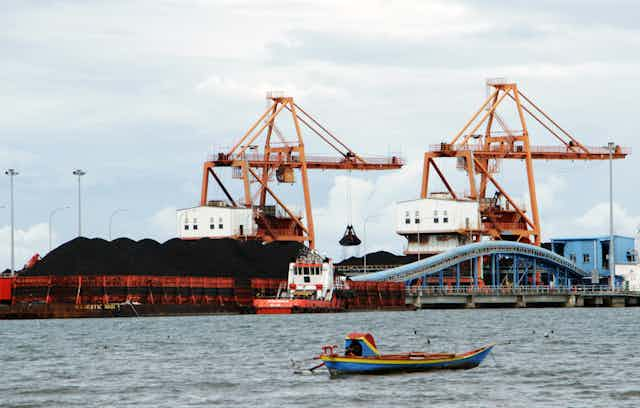Indonesia, one of the world’s biggest coal producers and greenhouse emitters, plans to launch its pilot emissions trading scheme in July, which can possibly lead to the implementation of the first national carbon market in Southeast Asia.
Indonesia has also established the foundations necessary for a domestic carbon market. It laid out a legal basis for carbon pricing instruments, including Indonesia’s own scheme, through a presidential decree issued in 2021.
There are many aspects to consider in designing an efficient and cost-effective scheme. Our previous article outlined some of them. But one crucial issue is that of transparency.
Transparency will be vital, ensuring monitoring and enforcement and allowing fairness across regulated entities.
Read more: Three steps Indonesia can take to create a solid domestic carbon market
What else is needed to improve transparency?
Drawing on the World Bank’s FASTER Principles for Successful Carbon Pricing, Indonesia has three points to consider to further enhance the scheme’s transparency.
1. Standardisation
First, the government needs to clarify a standardised monitoring system.
Standardisation leads to more consistent national greenhouse gas emission stocktaking. International standardisation, in particular, signals that the procedure in place is adequate and globally acceptable – crucial for both global market integration and for Indonesia’s commitments to reduce national emissions and adapt to the impacts of climate change. And a standardised monitoring lays an even playing field, ensuring fairness for all regulated entities.
However, while standards are fundamental to sound measurement and verification, the stipulation that governs the monitoring procedure does not explicitly oblige the regulated entities to execute specific criteria.
We have several standards in place.
The first is the 2006 Intergovernmental Panel on Climate Change (IPCC) guidelines, which the Indonesian government has already adopted and implemented for national and regional emission stocktaking.
We also have international standardisation for measurement and verification at an organisational level. In this case, the government must explicitly require either standard or other standards for the monitoring procedures in the follow-up regulation.
2. Allocation
The second issue is the allocation method.
There should be clear information on how the Indonesian government allocates emissions allowances, including assumptions in the methodology used to determine them.
An auction would be the most transparent, although this may be politically difficult.
The government plans to allocate allowances freely through the Ministry of Energy and Mineral Resources in the upcoming pilot project to attract companies to participate.
Since the free allocation is intrinsically less transparent than an auction, the Indonesian government must disclose its methodology to increase the perceived fairness by the regulated entities.
For example, the European Union’s emissions trading system uses a precise method to determine a benchmark value and allocation formula. It will also be vital to transparently set a cap for regulated entities as this is essential to fairness.
3. Verification
Finally, the government needs to consider carefully the availability and accessibility of up-to-date, accurate and verified information.
Accountability is only possible with sufficient and correct data, with which interested stakeholders may judge and evaluate a policy. In addition, access must also be easy and provided at a reasonably low cost. A dedicated website would be sufficient for this purpose.
It will be necessary for the government to publish compliance data. Further information is also recommended.
For example, each pilot emission trading in China has an online registry and an emission exchange centre to provide information about trading amounts, turnover, average trading price, price evaluation, and annual or quarterly summaries of transaction positions.
The state of California also publicises caps, counterfactual emissions, and estimated emissions from other policies contributing to emissions reductions. This information helps readers more easily compare emission trading systems’ impacts with alternative abatement policies.
According to a Ministry of Environment and Forestry’s regulation, one of the purposes of the national registry system is to keep the public informed about climate mitigation actions and achievements.
The government has already used the registry to provide important information about past climate mitigation actions. Next, it should operate this registry as a one-stop shop for all interested stakeholders to get relevant information on the implementation of the emission trading schemes.
The resources Indonesia needs to implement these steps are already available
Transparency is pivotal to a well-functioning and effective emissions trading scheme. Improving the program’s accountability will amplify general public involvement in monitoring and evaluation. Greater fairness will, in turn, gain more political support from regulated entities and increase participation.
Fortunately, the resources needed to improve transparency are publicly available for the Indonesian government’s perusal.
Concerning the standardisation, the government only needs to enforce the 2006 Intergovernmental Panel on Climate Change (IPCC) guidelines and the international standards by explicitly including them in updated monitirong regulations. In fact, the IPCC guidelines have already been adopted and implemented for national and regional emissions stocktaking.
The government also plans to implement benchmarking. In this case, they can easily refer to the EU’s schemes to determine necessary information regarding their allowances allocation methodology.
Lastly, the government already has a national registry, which gathers data from regulated entities regarding their climate mitigation actions and provides information to the general public. This could easily provide a similar function to progress the design and implementation of their emission trading schemes.

